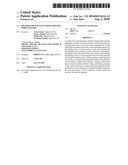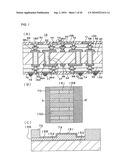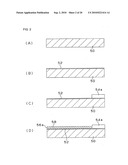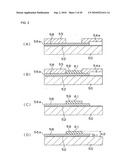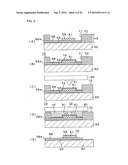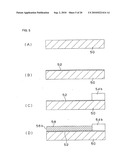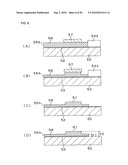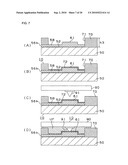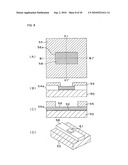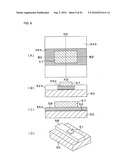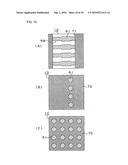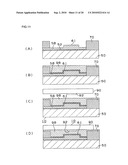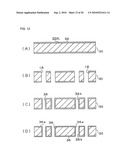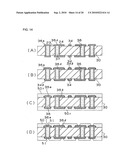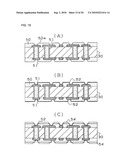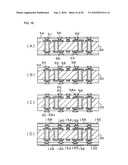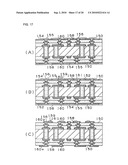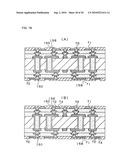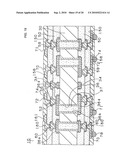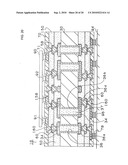Patent application title: METHOD FOR MANUFACTURING PRINTED WIRING BOARD
Inventors:
Toru Furuta (Ogaki-Shi, JP)
Toru Furuta (Ogaki-Shi, JP)
Kotaro Takagi (Ogaki-Shi, JP)
Michio Ido (Ogaki-Shi, JP)
Fumitaka Takagi (Ogaki-Shi, JP)
Fumitaka Takagi (Ogaki-Shi, JP)
Assignees:
IBIDEN, CO., LTD.
IPC8 Class: AB05D512FI
USPC Class:
427 988
Class name: Integrated circuit, printed circuit, or circuit board with pretreatment of substrate etching or roughening
Publication date: 2010-09-02
Patent application number: 20100221414
g a printed wiring board includes preparing
insulative board having first and second surfaces, forming metal film on
the first surface, plating resist on the metal film and plated-metal film
on the metal film exposed by the plating resist, covering portion of the
plated-metal film with etching resist, etching to reduce thickness of the
plated-metal film exposed by the etching resist, removing the etching and
plating resists, by removing the metal film exposed after removing the
plating resist, forming wiring comprising pad for electronic component
having gold bump and conductive circuit which is thinner than the pad,
forming solder-resist layer on the first surface and the wiring, and
forming opening in the solder-resist layer to expose the pad and portion
of the conductive circuit contiguous to the pad and metal coating on the
pad and portion of the conductive circuit, which are exposed through the
opening.Claims:
1. A method for manufacturing a printed wiring board, comprising:preparing
an insulative board having a first surface and a second surface opposite
the first surface;forming a metal film on the first surface of the
insulative board;forming a plating resist on the metal film;forming a
plated-metal film on the metal film left exposed by the plating
resist;covering a portion of the plated-metal film with an etching
resist;etching to reduce a thickness of the plated-metal film left
exposed by the etching resist;removing the etching resist;removing the
plating resist;by removing the metal film which is exposed after removing
the plating resist, forming wiring comprising a pad to mount an
electronic component having a gold bump and a conductive circuit which is
thinner than the pad;forming a solder-resist layer on the first surface
of the insulative board and on the wiring;forming an opening in the
solder-resist layer to expose the pad and a portion of the conductive
circuit contiguous to the pad; andforming a metal coating on the pad and
a portion of the conductive circuit, which are exposed through the
opening.
2. The method for manufacturing a printed wiring board according to claim 1, wherein the pad comprises the metal film and the plated-metal film on the metal film.
3. The method for manufacturing a printed wiring board according to claim 2, wherein the plated-metal film that forms the pad is the plated-metal film exposed by removing the etching resist.
4. The method for manufacturing a printed wiring board according to claim 2, wherein the conductive circuit comprises the metal film and the plated-metal film formed on the metal film, and the thickness of the plated-metal film that forms the conductive circuit is less than the thickness of the plated-metal film that forms the pad.
5. The method for manufacturing a printed wiring board according to claim 1, wherein the conductive circuit comprises the metal film.
6. The method for manufacturing a printed wiring board according to claim 4, wherein the thickness of the plated-metal film that forms the conductive circuit is made thinner by reducing the thickness.
7. The method for manufacturing a printed wiring board according to claim 1, wherein a thickness of the pad is 2-10 μm greater than a thickness of the conductive circuit.
8. The method for manufacturing a printed wiring board according to claim 1, wherein a width of the pad is substantially the same as a width of the conductive circuit.
9. The method for manufacturing a printed wiring board according to claim 1, wherein the metal coating comprises at least one metal selected from the group consisting of Au, Ni, Pd, Pt, Pb, Ag, Sn and Zn.
10. A method for manufacturing a printed wiring board, comprising:preparing an insulative board having a first surface and a second surface opposite the first surface;forming a metal film on the first surface of the insulative board;covering part of the metal film with a first plating resist;forming a first plated-metal film on the metal film left exposed by the first plating resist;covering a portion of the first plated-metal film with a second plating resist;forming a second plated-metal film on the first plated-metal film left exposed by the second plating resist;removing the first and second plating resists;by removing the metal film left exposed by the first and second plated-metal films, forming wiring comprising a pad to mount an electronic component having a gold bump and of a conductive circuit thinner than the pad;forming a solder-resist layer on the first surface of the insulative board and the wiring;forming an opening in the solder-resist layer to expose the pad and a portion of the conductive circuit contiguous to the pad; andforming a metal coating on the pad.
11. The method for manufacturing a printed wiring board according to claim 10, wherein a thickness of the pad is 2-10 μm greater than the thickness of a conductive circuit.
12. The method for manufacturing a printed wiring board according to claim 10, wherein a width of the pad is substantially the same as a width of the conductive circuit.
13. The method for manufacturing a printed wiring board according to claim 10, further comprising forming a metal coating on the pad and a portion of the conductive circuit, which are exposed through the opening of the solder-resist layer.
14. The method for manufacturing a printed wiring board according to claim 10, wherein the metal coating comprises at least one metal selected from the group consisting of Au, Ni, Pd, Pt, Pb, Ag, Sn and Zn.Description:
CROSS-REFERENCE TO RELATED APPLICATIONS
[0001]The present application claims the benefits of priority to U.S. Application No. 61/156,108, filed Feb. 27, 2009. The contents of that application are incorporated herein by reference in their entirety.
BACKGROUND OF THE INVENTION
[0002]1. Field of the Invention
[0003]The present invention is related to a method for manufacturing a printed wiring board on which to mount an electronic component such as an IC chip; especially to a method for manufacturing a printed wiring board having a pad to make an Au-Au connection or a connection using anisotropic conductive film with an electrode such as a gold-stud bump of an electronic component.
[0004]2. Discussion of the Background
[0005]In Japanese Laid-Open Patent Publication 2001-244365, the content of which are incorporated herein by reference in their entirety, a wiring board is described in which a pad protruding from a wiring layer is connected to a pad of a semiconductor element by means of an anisotropic conductive material. Here, to form a pad protruding from a wiring layer, an etching resist is formed on the pad and the rest of the wiring layer is etched.
SUMMARY OF THE INVENTION
[0006]A method for manufacturing a printed wiring board according to one aspect of the present invention includes as follows: preparing an insulative board having a first surface and a second surface opposite the first surface; forming a metal film on the first surface of the insulative board; forming a plating resist on the metal film; forming a plated-metal film on the metal film left exposed by the plating resist; covering part of the plated-metal film with an etching resist; etching to reduce the thickness of the plated-metal film left exposed by the etching resist; removing the etching resist; removing the plating resist; by removing the metal film which is exposed after removing the plating resist, forming wiring made up of a pad to mount an electronic component having a gold bump and of a conductive circuit which is thinner than the pad; forming a solder-resist layer on the first surface of the insulative board and on the wiring; forming an opening in the solder-resist layer to expose the pad and part of the conductive circuit contiguous to the pad; and forming a metal coating on the pad and part of the conductive circuit, which are exposed through the opening.
[0007]Also, a method for manufacturing a printed wiring board according to another aspect of the present invention includes as follows: preparing an insulative board having a first surface and a second surface opposite the first surface; forming a metal film on the first surface of the insulative board; covering part of the metal film with a first plating resist; forming a first plated-metal film on the metal film left exposed by the first plating resist; covering part of the first plated-metal film with a second plating resist; forming a second plated-metal film on the first plated-metal film left exposed by the second plating resist; removing the first and second plating resists; by removing the metal film left exposed by the first and second plated-metal films, forming wiring made up of a pad to mount an electronic component having a gold bump and of a conductive circuit thinner than the pad; forming a solder-resist layer on the first surface of the insulative board and the wiring; forming an opening in the solder-resist layer to expose the pad and part of the conductive circuit contiguous to the pad; and forming a metal coating on the pad.
BRIEF DESCRIPTION OF THE DRAWINGS
[0008]A more complete appreciation of the invention and many of the attendant advantages thereof will be readily obtained as the same becomes better understood by reference to the following detailed description when considered in connection with the accompanying drawings, wherein:
[0009]FIG. 1A is a cross-sectional view of a multilayer printed wiring board according to an embodiment of the present invention;
[0010]FIG. 1B is a top view of a multilayer printed wiring board according to an embodiment of the present invention;
[0011]FIG. 1C is a cross-sectional view of a multilayer printed wiring board according to an embodiment of the present invention;
[0012]FIG. 2A to 2D are views showing the steps of a method for manufacturing a printed wiring board according to the First Embodiment;
[0013]FIGS. 3A to 3D are views showing the steps of a method for manufacturing a printed wiring board according to the First Embodiment;
[0014]FIGS. 4A to 4E are views showing the steps of a method for manufacturing a printed wiring board according to the First Embodiment;
[0015]FIGS. 5A to 5D are views showing the steps of a method for manufacturing a printed wiring board according to the Second Embodiment;
[0016]FIGS. 6A to 6D are views showing the steps of a method for manufacturing a printed wiring board according to the Second Embodiment;
[0017]FIGS. 7A to 7D are views showing the steps of a method for manufacturing a printed wiring board according to the Second Embodiment;
[0018]FIG. 8A is a top view showing a modified example of the multilayer printed wiring board according to the First Embodiment;
[0019]FIGS. 8B and 8C are cross sectional views showing a modified example of the multilayer printed wiring board according to the First Embodiment;
[0020]FIG. 8D is a perspective view showing a modified example of the multilayer printed wiring board according to the First Embodiment;
[0021]FIG. 9A is a top view of a modified example of the multilayer printed wiring board according to the Second Embodiment;
[0022]FIGS. 9B and 9C are cross sectional views of a modified example of the multilayer printed wiring board according to the Second Embodiment;
[0023]FIG. 9D is a perspective view of a modified example of the multilayer printed wiring board according to the Second Embodiment;
[0024]FIGS. 10A to 10C are plan views showing modified examples of a printed wiring board according to the present invention;
[0025]FIGS. 11A to 11D are views showing the steps of a method for manufacturing a printed wiring board according to the Third Embodiment;
[0026]FIGS. 12A to 12D are views showing the steps of a method for manufacturing a multilayer printed wiring board according to the Example of the present invention;
[0027]FIGS. 13A to 13E are views showing the steps of a method for manufacturing a multilayer printed wiring board according to the Example of the present invention;
[0028]FIGS. 14A to 14D are views showing the steps of a method for manufacturing a multilayer printed wiring board according to the Example of the present invention;
[0029]FIGS. 15A to 15C are views showing the steps of a method for manufacturing a multilayer printed wiring board according to the Example of the present invention;
[0030]FIGS. 16A to 16D are views showing the steps of a method for manufacturing a multilayer printed wiring board according to the Example of the present invention;
[0031]FIGS. 17A to 17C are views showing the steps of a method for manufacturing a multilayer printed wiring board according to the Example of the present invention;
[0032]FIGS. 18A and 18B are views showing the steps of a method for manufacturing a multilayer printed wiring board according to the Example of the present invention;
[0033]FIG. 19 is a cross-sectional view of a multilayer printed wiring board according to the Example; and
[0034]FIG. 20 is a cross-sectional view showing a state in which an IC chip is mounted on a multilayer printed wiring board according to the First Embodiment.
DETAILED DESCRIPTION OF THE EMBODIMENTS
[0035]The embodiments will now be described with reference to the accompanying drawings, wherein like reference numerals designate corresponding or identical elements throughout the various drawings.
First Embodiment
[0036]The structure of a printed wiring board according to the present invention is described with reference to FIGS. 1A-1C. FIG. 1A is a cross-sectional view showing multilayer printed wiring board 10. In multilayer printed wiring board 10, conductive circuits 34 are formed on the surfaces of core substrate 30. The front and back surfaces of core substrate 30 are connected by means of through-holes 36. Through-holes 36 are made up of plated cover layers (36a, 36d) which form through-hole lands and of side-wall conductive layers (36b). In the interiors surrounded by side-wall conductive layers (36b), resin filler 37 is filled. Resin insulation layers 50 having filled vias 60 and conductive circuits 58 and resin insulation layers 150 having filled vias 160 and conductive circuits 158 are formed on plated cover layers (through-hole lands) (36a, 36d). Pads 161 are formed at predetermined spots of upper-side conductive circuits 158. Solder resist layers 70 are formed on resin insulation layers 150. Part of conductive circuits 158 and pads 161 are exposed through opening portions 71 of upper-side solder resist layer 70; and bumps 78 are formed in lower-side opening portions 71.
[0037]FIG. 1B is a magnified top view showing part of multilayer printed wiring board 10. FIG. 1C is a cross-sectional view seen from the (A-A') line in FIG. 1B. The thickness of pad 161 is set to be greater than the thickness of conductive circuit 158, preferably approximately 2-10 μm thicker. Pad 161 is used for electrically connecting the wiring board and an electronic component such as a semiconductor chip. Metal film 74 such as Au is coated on the pad surface according to requirements.
[0038]Next, a method for manufacturing printed wiring board 10 according to the First Embodiment of the present invention is described with reference to FIGS. 2A-4E.
[0039](1) On resin insulation layer 50 made of resin (FIG. 2A), metal film 52 made of copper or the like is formed (FIG. 2B). Such metal film may be formed by electroless copper plating. Here, instead of forming plated-metal film, metal foil may be laminated.
[0040](2) First plating resist (54a) for forming a pad and conductive circuit is formed on metal film 52 (FIG. 2C). Then, the substrate is immersed in an electrolytic plating solution, and an electrical current is passed through metal film 52. Accordingly, first electrolytic copper-plated film (56a) is formed in the area where plating resist is not formed (FIG. 2D).
[0041](3) Second plating resist 55 for forming a pad is formed on first electrolytic copper-plated film (56a), which will become conductive circuit (FIG. 3A). The substrate is immersed in an electrolytic plating solution, and second electrolytic copper-plated film 59 with a thickness of 2-10 μm is formed on the area of first electrolytic copper-plated film (56a) where second plating resist 55 is not formed (FIG. 3B).
[0042](4) First plating resist (54a) and second plating resist 55 are removed and the following are formed: conductive circuit 58 made from first electrolytic copper-plated film (56a), and pad 61 made up of first electrolytic copper-plated film (56a) and second electrolytic copper-plated film 59 formed on first electrolytic copper-plated film (56a) (FIG. 3C). Then, metal film 52 under first plating resist (54a) is removed by etching (FIG. 3D). In doing so, conductive circuit 58 with thickness (h1) of 15 μm and pad 61 with thickness (h2) of 18-25 μm are formed.
[0043](5) On resin insulation layer 50, opening portion 71 exposing pad 61 is arranged and solder resist layer 70 with thickness (h3) of 25-35 μm is formed (FIG. 4A). Here, opening portion 71 may expose the pad only, or may expose the surrounding portion of the pad as well.
[0044](6) On pad 61 exposed through opening portion 71, metal coating 72 made of nickel-gold is formed (FIG. 4B). In doing so, printed wiring board 10 is completed. In another example, metal coating 72 made of nickel-gold may be formed after electrolytic copper-plated film 59 shown in FIG. 3B is formed. In such a case, a metal coating is formed only on the top surface of the pad (FIG. 4E). The thickness of pad 61 is preferred to be set lower than solder-resist layer 70. It is possible to form pad 61 to be thicker than solder-resist layer 70; however, since the mounting position of an electronic component rises, the pad is preferred to be set lower than the solder-resist layer from the viewpoint of making a lightweight and thinner type. For metal coating 72, other than nickel and gold, a metal selected from among palladium, platinum, silver, lead, zinc and tin may be used.
[0045]In the following, mounting an IC chip on printed wiring board 10 is described. Gold-stud bump 91 of IC chip 90 to be mounted on the printed wiring board is aligned to face pad 61 of printed wiring board 10 (FIG. 4C). Then, IC chip 90 is pressed against printed wiring board 10, gold-stud bump 91 and pad 61 are connected, IC chip 90 is mounted on printed wiring board 10, and underfill (UF) is filled between IC chip 90 and printed wiring board 10 (FIG. 4D).
[0046]In a printed wiring board according to the manufacturing method of the First Embodiment, pad 61 is made up of first electrolytic copper-plated film (56a) and second electrolytic copper-plated film 59 with a thickness of 2-10 μm, and is 2-10 μm thicker than conductive circuit 58 made from first electrolytic copper-plated film (56a). Thus, when mounting an electronic component such as an IC chip, the electronic component will not come in contact with the solder-resist layer. Accordingly, during the mounting process, it is easier to exert pressure, and connection reliability may be enhanced. Also, since the thickness is increased by forming the second plated-metal film on the first plated-metal film, compared with a manufacturing method in which the thickness is reduced through etching using an etching resist, side etching will not occur on the pad and conductive circuit. Thus, connection reliability will not decrease in the pad and conductive circuit.
[0047]In a printed wiring board according to the manufacturing method of the First Embodiment, metal coating 72 is formed on pad 61, which is then connected to gold-stud bump 91. Since the pad is thick, heavy pressure may be exerted when gold-stud bump 91 is pressed against pad 61, leading to high connection reliability.
[0048]Moreover, in a printed wiring board according to the manufacturing method of the First Embodiment, when gold-stud bump 91 is pressed against pad 61, even if solder resist layer 70 comes in contact with IC chip 90, connection reliability may be enhanced, since pad 61 is thick and the pressure exerted on gold-stud bump 91 is heavy.
Second Embodiment
[0049]Printed wiring board 10 according to the Second Embodiment of the present invention is described with reference to FIGS. 5A-7D.
[0050](1) On resin insulation layer 50 made of resin (FIG. 5A), metal film 52 made of copper or the like is formed (FIG. 5B). Such metal film may be formed by electroless copper plating. Here, instead of forming plated-metal film, metal foil may be laminated.
[0051](2) Plating resist (54b) for forming a pad and conductive circuit is formed on metal film 52 (FIG. 5C). Then, the substrate is immersed in an electrolytic plating solution, and an electrical current is passed through metal film 52. Accordingly, electrolytic copper-plated film (56b) with a thickness of 18-25 μm is formed in the area where plating resist is not formed (FIG. 5D).
[0052](3) Etching resist 57 is formed on the area of electrolytic copper-plated film (56b) that will become a pad (FIG. 6A). The substrate is immersed in an etchant, and portions of the surface of electrolytic copper-plated film (56b) where etching resist 57 is not formed are etched away by a thickness of 2-10 μm (FIG. 6B). The resultant portions will become conductive circuit.
[0053](4) Plating resist (54b) and etching resist 57 are removed and the following are formed: conductive circuit 58 made from the portions of electrolytic copper-plated film (56b) which were etched by a thickness of 2-10 μm, and pad 61 made from the portion of electrolytic copper-plated film (56b) which was not etched (FIG. 6C). Then, metal film 52 under plating resist (54b) is removed by etching (FIG. 6D). By doing so, conductive circuit 58 with thickness (h1) of 15 μm and pad 61 with thickness (h2) of 18-25 μm are formed.
[0054](5) On resin insulation layer 50, opening portion 71 exposing pad 61 is arranged and solder resist layer 70 with thickness (h3) of 25-35 μm is formed (FIG. 7A).
[0055](6) On pad 61 exposed through opening portion 71, metal coating 72 made of nickel-gold is formed (FIG. 7B). Accordingly, printed wiring board 10 is completed.
[0056]Next, mounting an IC chip on printed wiring board 10 is described. Gold-stud bump 91 of IC chip 90 to be mounted on the printed wiring board is aligned to face pad 61 of printed wiring board 10 (FIG. 7C). Then, IC chip 90 is pressed against printed wiring board 10, gold-stud bump 91 and pad 61 are connected, IC chip 90 is mounted on printed wiring board 10, and underfill (UF) is filled between IC chip 90 and printed wiring board 10 (FIG. 7D).
[0057]In printed wiring board 10 according to the manufacturing method of the Second Embodiment, pad 61 is thicker than conductive circuit 58, whose thickness is etched away by 2-10 μm. Thus, during the mounting process, it is easier to exert pressure, and connection reliability may be enhanced. Also, during the etching, because plating resist (54a) remains on the side surface of pad 61 and the side surface of conductive circuit 58, side etching will not occur on pad 61 and conductive circuit 58. Thus, reliability will not decrease in the pad and conductive circuit, compared with a manufacturing method in which side etching will occur during etching using an etching resist to reduce the thickness of the wiring.
[0058]In printed wiring boards described in the First and Second Embodiments, the width of pads is not limited to those having the same width as the circuit. As shown in FIG. 10A, multiple rectangular pads 61 may be exposed through opening 71 arranged in solder-resist layer 70. Alternatively, as shown in FIG. 10B, pads 61 with a substantially circular shape may be formed. Also, as shown in FIG. 10C, only pads may be formed in a grid configuration and exposed through the solder resist, which is higher than such pads.
[0059]Furthermore, as a modified example of the First Embodiment, the following method may also be employed. FIG. 8A is a top view showing second plating resist 55 formed on printed wiring board 10. FIGS. 8B and 8C are cross-sectional views taken respectively from the (H1-H1') line and (W1-W1') line in FIG. 8A. Second plating resist 55 is formed to be narrower than the width of the first electrolytic copper-plated film. In such a case, pad 61 formed later will be set to be narrower than conductive circuit 58 both lengthwise and crosswise as shown in FIG. 8D.
[0060]Also, the following may be employed as a modified example of the Second Embodiment. FIG. 9A is a top view showing etching resist 57 formed on the first electrolytic copper-plated film. FIGS. 9B and 9C are cross-sectional views taken respectively from the (H2-H2') line and (W2-W2') line in FIG. 9A. Etching resist 57 is formed to be narrower than the width of the first electrolytic copper-plated film. In such a case, pad 61 formed later will be set to be narrower than conductive circuit 58 both lengthwise and crosswise as shown in FIG. 9D.
Third Embodiment
[0061]A method for manufacturing printed wiring board 10 according to the Third Embodiment of the present invention is described with reference to FIGS. 11A to 11D. Using steps (1)-(4) of the First Embodiment or steps (1)-(4) of the Second Embodiment, circuit 58 and pad 61, which is set to be 2-10 μm thicker than the circuit, are formed on resin insulation layer 50 (FIG. 11A). Then, anisotropic conductive film (ACF) 98, containing conductive particles made of metal or the like in resin film, is arranged on resin insulation layer 50, and printed wiring board 10 is completed (FIG. 11B).
[0062]Bump 92 of IC chip 90 to be mounted on a printed wiring board is aligned to face pad 61 of printed wiring board 10 (FIG. 11C). Then, IC chip 90 is pressed against printed wiring board 10, bump 92 and pad 61 are connected by means of ACF 98, and IC chip 90 is mounted on printed wiring board 10 (FIG. 11D).
[0063]Since pad 61 is thicker than circuit 58 in printed wiring board 10 of the Third Embodiment, only pad 61 makes connection with bump 92 by means of anisotropic conductive film (ACF) 98 without causing short-circuiting in circuit 58.
EXAMPLE
[0064]The structure of built-up multilayer printed wiring board 10 according to an Example of the present invention is described with reference to FIGS. 12A to 20. FIG. 19 is a cross-sectional view showing multilayer printed wiring board 10, and FIG. 20 is a view showing a state in which IC chip 90 is mounted on multilayer printed wiring board 10 shown in FIG. 19, which is further mounted on daughterboard 94. As shown in FIG. 19, in multilayer printed wiring board 10, conductive circuits 34 are formed on the surfaces of core substrate 30. The front and back surfaces of core substrate 30 are connected by means of through-holes 36. Through-holes 36 are made up of plated cover layers (36a, 36d) which form through-hole lands and of side-wall conductive layers (36b). Resin filler 37 is filled in the interiors surrounded by side-wall conductive layers (36b). Resin insulation layers 50 having filled vias 60 and conductive circuits 58 and resin insulation layers 150 having filled vias 160 and conductive circuits 158 are formed on plated cover layers (through-hole lands) (36a, 36d). Pads 161 are formed at predetermined spots of upper-side conductive circuit 158. Solder resist layers 70 are formed on resin insulation layers 150. Pads 161 are exposed through opening portions 71 of upper-side solder resist layer 70; and bumps 78 are formed in lower-side opening portions 71.
[0065]As shown in FIG. 20, upper-side pads 161 of multilayer printed wiring board 10 are connected to bumps 92 of IC chip 90 by means of gold-stud bumps 91. Meanwhile, lower-side solder bumps 78 are connected to lands 96 of daughterboard 94.
[0066]Next, a method for manufacturing multilayer printed wiring board 10 described with reference to FIG. 20 is described by referring to FIGS. 12A to 19.
[0067](1) Copper-clad laminate (30A) was prepared as a starting material. The copper clad-laminate was made by laminating copper foil 32 with a thickness of 5-250 μm on both surfaces of insulative substrate 30 made of glass-epoxy resin or bismaleimide triazine (BT) resin with a thickness of 0.2-0.8 mm (FIG. 12A). First, by drilling the copper-clad laminate, penetrating holes 16 were formed (FIG. 12B). Then, side-wall conductive layers (36b) of through-holes 36 were formed by performing electroless plating and electrolytic plating (see later-described plating solution and conditions (steps (13) and (15)) (FIG. 12C). The opening diameter of penetrating holes 16 was set at Φ0.1-0.25 mm by drill selection, and the pitch was set at 0.15-0.575 mm.
[0068](2) Substrate 30 with through holes 36 was washed with water and dried, a black-oxide treatment was conducted using a solution containing NaOH (10 g/l), NaClO2 (40 g/l) and Na3PO4 (6 g/l) as a black-oxide bath (oxidation bath), followed by a reduction treatment using a solution containing NaOH (10 g/l) and NaBH4 (6 g/l) as a reduction bath. Accordingly, roughened surfaces (36α) were formed on side-wall conductive layers (36b) of through-holes 36 and on the surfaces of the substrate (FIG. 12D).
[0069](3) Next, filler 37 (non-conductive copper paste padding, brand name: DD paste, made by Tatsuta Electric Wire & Cable, Co., Ltd.) containing copper particles with an average particle diameter of 10 μm was filled in through-holes 36 by screen printing, dried and cured (FIG. 13A). A mask with openings corresponding to through-hole portions was placed on the substrate, and the paste was applied by printing to fill the through-holes. After that, the paste was dried and cured.
[0070]In the following, filler 37 bulging from through-holes 36 was removed by belt-sander polishing using #600 belt sanding paper (made by Sankyo-Rikagaku Co., Ltd.). Then, buff polishing to remove scratches from such belt sanding was conducted to level the surfaces of substrate 30 (see FIG. 13B). In doing so, substrate 30 was obtained where side-wall conductive layers (36b) of through-holes 36 and resin filler 37 were firmly adhered by means of roughened layer (36α).
[0071](4) On the surfaces of substrate 30 leveled in step (3), palladium catalyst (made by Atotech) was applied and electroless copper plating was performed. Accordingly, electroless copper-plated films 23 with a thickness of 0.6 μm were formed (see FIG. 13C).
[0072](5) Next, electrolytic copper plating was performed under the following conditions to form electrolytic copper-plated films 24 with a thickness of 15 μm. The portions that will become conductive circuits 34 were thickened, and the portions that will become plated cover layers (through-hole lands) to cover filler 37 filled in through-holes 36 were formed (FIG. 13D).
TABLE-US-00001 [electrolytic plating solution] sulfuric acid 180 g/l copper sulfate 80 g/l additive 1 ml/l (brand name: Cupracid GL, made by Atotech Japan) [electrolytic plating conditions] current density 1 A/dm2 time 30 minutes temperature room temperature
[0073](6) On both surfaces of substrate 30 where portions that will become conductive circuits and plated cover layers were formed, commercially available photosensitive dry film was laminated, and a patterned mask was placed on the film, which was then exposed to light at 100 mJ/cm2 and developed with a 0.8% sodium carbonate solution. Accordingly, etching resists 25 with a thickness of 15 μm were formed (see FIG. 13E).
[0074](7) Next, portions of plated-metal films (23, 24) and copper foil 32 where etching resist 25 was not formed were dissolved and removed by an etchant mainly containing copper (II) chloride. Then, etching resists 25 were removed by a 5% KOH solution. Accordingly, independent circuits 34 and plated cover layers (36a, 36d) covering filler 37 were formed (see FIG. 14A). This process is a so-called tenting method.
[0075](8) Next, roughened layers (34β) were formed on the surfaces of conductive circuit 34 and plated cover layers (36a, 36d) covering filler 37, using a micro etchant (CZ series) made by Mec Co., Ltd. (FIG. 14B).
[0076](9) On both surfaces of the substrate, resin film (50γ) for interlayer solder-resist layer (brand name ABF-45SH, made by Ajinomoto Fine-Techno Co., Inc.) with a slightly larger size than the substrate was placed and preliminarily pressed under the conditions of pressure 0.45 MPa, temperature 80° C. and pressing time 10 seconds, and cut to size. Then, by laminating the film using vacuum laminator equipment under the following conditions, resin insulation layers 50 were formed (FIG. 14C). Namely, the resin film for interlayer solder-resist layer on the substrate was given a final pressing under the conditions of vacuum degree 67 Pa, pressure 0.47 MPa, temperature 85° C. and pressing time 60 seconds, and then thermoset at 170° C. for 40 minutes.
[0077](10) Next, using a CO2 gas laser with a wave length of 10.4 μm, via hole openings (51) were formed in resin insulation layers 50 under the conditions of beam diameter 4.0 mm, top-hat mode, pulse width 3-30 μsec., mask through-hole diameter 1.0-5.0 mm and number of shots 1-3 (FIG. 14D). The above laser conditions were adjusted so that the bottom diameter of via holes in resin insulation layers 50 would become Φ60 μm. As a result, the bottom diameter of the via holes formed on plated cover layers (36a, 36d) was made Φ60 μm.
[0078](11) The substrate with filled-via openings 51 was immersed for 10 minutes in an 80° C. solution containing permanganic acid 60 g/l, and epoxy-resin particles residing on the surfaces of resin insulation layers 50 were dissolved and removed. Accordingly, roughened surfaces (50a) were formed on the surfaces of resin insulation layers 50 including the inner walls of filled-via openings 51 (FIG. 15A).
[0079](12) Next, after the above treatments, the substrate was immersed in a neutralizer (made by Shipley Company, LLC) and was washed with water. Furthermore, by applying palladium catalyst on the roughened surfaces (roughened depth 3 μm) of the substrate, catalyst nuclei were adhered to the surfaces of the resin solder-resist layers and the inner-wall surfaces of the filled-via openings. Namely, the substrate was immersed in a catalytic solution containing palladium chloride (PbC12) and stannous chloride (SnC12), and the catalyst was adhered to the surfaces through deposition of palladium metal.
[0080](13) Next, the substrate with applied catalyst was immersed in an electroless copper plating solution (Thru-Cup PEA) made by C. Uyemura & Co., Ltd. to form electroless copper-plated film with a thickness of 0.3-3.0 μm on the entire roughened surfaces. Accordingly, the substrate was obtained where electroless copper-plated film 52 was formed on the surfaces of resin insulation layers 50 including the inner walls of via-hole opening 51 (FIG. 15B).
[Electroless Plating Conditions]
[0081]solution temperature at 34° C. for 45 minutes
[0082](14) On the substrate having electroless copper-plated film 52, commercially available photosensitive dry film was laminated, and a mask was placed on the film, which was then exposed to light at 110 mJ/cm2 and developed with a 0.8% sodium carbonate solution. Accordingly, plating resists 54 with a thickness of 25 μm were formed (FIG. 15C).
[0083](15) Then, after substrate 30 was cleansed with 50° C. water to degrease it and washed with 25° C. water, the substrate was further cleansed with sulfuric acid. Then, electrolytic plating was performed under the following conditions to form electrolytic plated-metal film 56 (FIG. 16A).
TABLE-US-00002 [electrolytic plating solution] sulfuric acid 2.24 mol/l copper sulfate 0.26 mol/l additive 19.5 ml/l leveling agent 50 mg/l polishing agent 50 mg/l [electrolytic plating conditions] current density 1 A/dm2 time 70 minutes temperature 22 ± 2° C.
[0084](16) Furthermore, after plating resists 54 were removed using a 5% KOH solution, electroless plated-metal film under the plating resists was removed by etching using a mixed solution of sulfuric acid and hydrogen peroxide. Accordingly, independent conductive circuits 58 and filled vias 60 were formed (FIG. 16B).
[0085](17) Next, by conducting the same treatment as in above step (8), roughened surfaces (58α) were formed on the surfaces of conductive circuits 58 and filled vias 60. The thickness of upper-layer conductive circuits 58 was 15 μm (FIG. 16C). However, the thickness of upper-layer conductive circuits may be set anywhere between 5 and 25 μm.
[0086](18) By repeating steps (9)-(15), conductive circuits 158 and filled vias 160 made of electroless plated-metal film 152 and electrolytic plated-metal film 156 were formed in areas of upper-layer resin insulation layers 150 where plating resist 154 was not formed (FIG. 16D).
[0087](19) Second plating resist 155 for forming pads was formed on copper-plated film 156 which will later become circuit patterns (FIG. 17A).
[0088](20) The substrate was immersed in an electrolytic plating solution to form electrolytic copper-plated film 159 with a thickness of 2-10 μm on copper-plated film 156 in areas where second plating resist 155 was not formed (FIG. 17B).
[0089](21) Plating resists 154 and second plating resists 155 were removed, and pads 161 made from copper-plated film 159 were formed on circuit 158, which was made from copper-plated film 156. Then, metal film 152 under plating resists 154 was etched away and roughened layers (160α) were formed (FIG. 17C).
[0090](22) Next, on both surfaces of a multilayer wiring substrate, commercially available solder-resist 70 was applied to be 25-35 μm thick, which was then dried at 70° C. for 20 minutes and at 70° C. for 30 minutes. Then, a 5-mm thick photomask with a pattern of solder-resist openings was adhered to solder resist layers 70, which were then exposed to ultraviolet rays at 1000 mJ/cm2 and developed using a DMTG solution. Accordingly, openings 71 were formed with a diameter of 200 μm (FIG. 18A).
[0091](23) Next, the substrate with solder-resist layers 70 was immersed for 20 minutes in an electroless nickel plating solution of pH=4.5 containing nickel chloride (2.3×10-1 mol/l), sodium hypophosphite (2.8×10-1 mol/l) and sodium citrate (1.6×10-1 mol/l); and a 0.5 μm-thick nickel-plated layer 72 was formed in opening portions 71. Furthermore, the substrate was immersed for 7.5 minutes at 80° C. in an electroless gold plating solution containing gold potassium cyanide (7.6×10-3 mol/l), ammonium chloride (1.9×10-1 mol/l), sodium citrate (1.2×10-1 mol/l) and sodium hypophosphite (1.7×10-1 mol/l). Accordingly, a 0.03 μm-thick gold-plated layer 74 was formed on nickel-plated layer 72 (FIG. 18B). Other than a nickel-gold layer, a single layer of tin or a noble metal layer (gold, silver, palladium, platinum or the like) may be formed.
[0092](24) After that, tin-antimony solder paste was printed in the openings of the lower-side solder resist layer. Then, a reflow was conducted at 200° C. to form solder bumps (solder bodies). Accordingly, a multilayer printed wiring board having solder bumps 78 was manufactured (FIG. 19).
[0093]In the following, mounting an IC chip on multilayer printed wiring board 10 and further mounting the wiring board on a daughterboard are described. Gold-stud bumps 91 of IC chip 90 to be mounted on the multilayer printed wiring board are aligned to face pads 161 of multilayer printed wiring board 10. Then, IC chip 90 is pressed against printed wiring board 10 to connect gold-stud bumps 91 and pads 161, and IC chip 90 is mounted on multilayer printed wiring board 10. Then, multilayer printed wiring board 10 is mounted on daughterboard 94 by means of solder bumps 78 (FIG. 20).
[0094]Obviously, numerous modifications and variations of the present invention are possible in light of the above teachings. It is therefore to be understood that within the scope of the appended claims, the invention may be practiced otherwise than as specifically described herein.
Claims:
1. A method for manufacturing a printed wiring board, comprising:preparing
an insulative board having a first surface and a second surface opposite
the first surface;forming a metal film on the first surface of the
insulative board;forming a plating resist on the metal film;forming a
plated-metal film on the metal film left exposed by the plating
resist;covering a portion of the plated-metal film with an etching
resist;etching to reduce a thickness of the plated-metal film left
exposed by the etching resist;removing the etching resist;removing the
plating resist;by removing the metal film which is exposed after removing
the plating resist, forming wiring comprising a pad to mount an
electronic component having a gold bump and a conductive circuit which is
thinner than the pad;forming a solder-resist layer on the first surface
of the insulative board and on the wiring;forming an opening in the
solder-resist layer to expose the pad and a portion of the conductive
circuit contiguous to the pad; andforming a metal coating on the pad and
a portion of the conductive circuit, which are exposed through the
opening.
2. The method for manufacturing a printed wiring board according to claim 1, wherein the pad comprises the metal film and the plated-metal film on the metal film.
3. The method for manufacturing a printed wiring board according to claim 2, wherein the plated-metal film that forms the pad is the plated-metal film exposed by removing the etching resist.
4. The method for manufacturing a printed wiring board according to claim 2, wherein the conductive circuit comprises the metal film and the plated-metal film formed on the metal film, and the thickness of the plated-metal film that forms the conductive circuit is less than the thickness of the plated-metal film that forms the pad.
5. The method for manufacturing a printed wiring board according to claim 1, wherein the conductive circuit comprises the metal film.
6. The method for manufacturing a printed wiring board according to claim 4, wherein the thickness of the plated-metal film that forms the conductive circuit is made thinner by reducing the thickness.
7. The method for manufacturing a printed wiring board according to claim 1, wherein a thickness of the pad is 2-10 μm greater than a thickness of the conductive circuit.
8. The method for manufacturing a printed wiring board according to claim 1, wherein a width of the pad is substantially the same as a width of the conductive circuit.
9. The method for manufacturing a printed wiring board according to claim 1, wherein the metal coating comprises at least one metal selected from the group consisting of Au, Ni, Pd, Pt, Pb, Ag, Sn and Zn.
10. A method for manufacturing a printed wiring board, comprising:preparing an insulative board having a first surface and a second surface opposite the first surface;forming a metal film on the first surface of the insulative board;covering part of the metal film with a first plating resist;forming a first plated-metal film on the metal film left exposed by the first plating resist;covering a portion of the first plated-metal film with a second plating resist;forming a second plated-metal film on the first plated-metal film left exposed by the second plating resist;removing the first and second plating resists;by removing the metal film left exposed by the first and second plated-metal films, forming wiring comprising a pad to mount an electronic component having a gold bump and of a conductive circuit thinner than the pad;forming a solder-resist layer on the first surface of the insulative board and the wiring;forming an opening in the solder-resist layer to expose the pad and a portion of the conductive circuit contiguous to the pad; andforming a metal coating on the pad.
11. The method for manufacturing a printed wiring board according to claim 10, wherein a thickness of the pad is 2-10 μm greater than the thickness of a conductive circuit.
12. The method for manufacturing a printed wiring board according to claim 10, wherein a width of the pad is substantially the same as a width of the conductive circuit.
13. The method for manufacturing a printed wiring board according to claim 10, further comprising forming a metal coating on the pad and a portion of the conductive circuit, which are exposed through the opening of the solder-resist layer.
14. The method for manufacturing a printed wiring board according to claim 10, wherein the metal coating comprises at least one metal selected from the group consisting of Au, Ni, Pd, Pt, Pb, Ag, Sn and Zn.
Description:
CROSS-REFERENCE TO RELATED APPLICATIONS
[0001]The present application claims the benefits of priority to U.S. Application No. 61/156,108, filed Feb. 27, 2009. The contents of that application are incorporated herein by reference in their entirety.
BACKGROUND OF THE INVENTION
[0002]1. Field of the Invention
[0003]The present invention is related to a method for manufacturing a printed wiring board on which to mount an electronic component such as an IC chip; especially to a method for manufacturing a printed wiring board having a pad to make an Au-Au connection or a connection using anisotropic conductive film with an electrode such as a gold-stud bump of an electronic component.
[0004]2. Discussion of the Background
[0005]In Japanese Laid-Open Patent Publication 2001-244365, the content of which are incorporated herein by reference in their entirety, a wiring board is described in which a pad protruding from a wiring layer is connected to a pad of a semiconductor element by means of an anisotropic conductive material. Here, to form a pad protruding from a wiring layer, an etching resist is formed on the pad and the rest of the wiring layer is etched.
SUMMARY OF THE INVENTION
[0006]A method for manufacturing a printed wiring board according to one aspect of the present invention includes as follows: preparing an insulative board having a first surface and a second surface opposite the first surface; forming a metal film on the first surface of the insulative board; forming a plating resist on the metal film; forming a plated-metal film on the metal film left exposed by the plating resist; covering part of the plated-metal film with an etching resist; etching to reduce the thickness of the plated-metal film left exposed by the etching resist; removing the etching resist; removing the plating resist; by removing the metal film which is exposed after removing the plating resist, forming wiring made up of a pad to mount an electronic component having a gold bump and of a conductive circuit which is thinner than the pad; forming a solder-resist layer on the first surface of the insulative board and on the wiring; forming an opening in the solder-resist layer to expose the pad and part of the conductive circuit contiguous to the pad; and forming a metal coating on the pad and part of the conductive circuit, which are exposed through the opening.
[0007]Also, a method for manufacturing a printed wiring board according to another aspect of the present invention includes as follows: preparing an insulative board having a first surface and a second surface opposite the first surface; forming a metal film on the first surface of the insulative board; covering part of the metal film with a first plating resist; forming a first plated-metal film on the metal film left exposed by the first plating resist; covering part of the first plated-metal film with a second plating resist; forming a second plated-metal film on the first plated-metal film left exposed by the second plating resist; removing the first and second plating resists; by removing the metal film left exposed by the first and second plated-metal films, forming wiring made up of a pad to mount an electronic component having a gold bump and of a conductive circuit thinner than the pad; forming a solder-resist layer on the first surface of the insulative board and the wiring; forming an opening in the solder-resist layer to expose the pad and part of the conductive circuit contiguous to the pad; and forming a metal coating on the pad.
BRIEF DESCRIPTION OF THE DRAWINGS
[0008]A more complete appreciation of the invention and many of the attendant advantages thereof will be readily obtained as the same becomes better understood by reference to the following detailed description when considered in connection with the accompanying drawings, wherein:
[0009]FIG. 1A is a cross-sectional view of a multilayer printed wiring board according to an embodiment of the present invention;
[0010]FIG. 1B is a top view of a multilayer printed wiring board according to an embodiment of the present invention;
[0011]FIG. 1C is a cross-sectional view of a multilayer printed wiring board according to an embodiment of the present invention;
[0012]FIG. 2A to 2D are views showing the steps of a method for manufacturing a printed wiring board according to the First Embodiment;
[0013]FIGS. 3A to 3D are views showing the steps of a method for manufacturing a printed wiring board according to the First Embodiment;
[0014]FIGS. 4A to 4E are views showing the steps of a method for manufacturing a printed wiring board according to the First Embodiment;
[0015]FIGS. 5A to 5D are views showing the steps of a method for manufacturing a printed wiring board according to the Second Embodiment;
[0016]FIGS. 6A to 6D are views showing the steps of a method for manufacturing a printed wiring board according to the Second Embodiment;
[0017]FIGS. 7A to 7D are views showing the steps of a method for manufacturing a printed wiring board according to the Second Embodiment;
[0018]FIG. 8A is a top view showing a modified example of the multilayer printed wiring board according to the First Embodiment;
[0019]FIGS. 8B and 8C are cross sectional views showing a modified example of the multilayer printed wiring board according to the First Embodiment;
[0020]FIG. 8D is a perspective view showing a modified example of the multilayer printed wiring board according to the First Embodiment;
[0021]FIG. 9A is a top view of a modified example of the multilayer printed wiring board according to the Second Embodiment;
[0022]FIGS. 9B and 9C are cross sectional views of a modified example of the multilayer printed wiring board according to the Second Embodiment;
[0023]FIG. 9D is a perspective view of a modified example of the multilayer printed wiring board according to the Second Embodiment;
[0024]FIGS. 10A to 10C are plan views showing modified examples of a printed wiring board according to the present invention;
[0025]FIGS. 11A to 11D are views showing the steps of a method for manufacturing a printed wiring board according to the Third Embodiment;
[0026]FIGS. 12A to 12D are views showing the steps of a method for manufacturing a multilayer printed wiring board according to the Example of the present invention;
[0027]FIGS. 13A to 13E are views showing the steps of a method for manufacturing a multilayer printed wiring board according to the Example of the present invention;
[0028]FIGS. 14A to 14D are views showing the steps of a method for manufacturing a multilayer printed wiring board according to the Example of the present invention;
[0029]FIGS. 15A to 15C are views showing the steps of a method for manufacturing a multilayer printed wiring board according to the Example of the present invention;
[0030]FIGS. 16A to 16D are views showing the steps of a method for manufacturing a multilayer printed wiring board according to the Example of the present invention;
[0031]FIGS. 17A to 17C are views showing the steps of a method for manufacturing a multilayer printed wiring board according to the Example of the present invention;
[0032]FIGS. 18A and 18B are views showing the steps of a method for manufacturing a multilayer printed wiring board according to the Example of the present invention;
[0033]FIG. 19 is a cross-sectional view of a multilayer printed wiring board according to the Example; and
[0034]FIG. 20 is a cross-sectional view showing a state in which an IC chip is mounted on a multilayer printed wiring board according to the First Embodiment.
DETAILED DESCRIPTION OF THE EMBODIMENTS
[0035]The embodiments will now be described with reference to the accompanying drawings, wherein like reference numerals designate corresponding or identical elements throughout the various drawings.
First Embodiment
[0036]The structure of a printed wiring board according to the present invention is described with reference to FIGS. 1A-1C. FIG. 1A is a cross-sectional view showing multilayer printed wiring board 10. In multilayer printed wiring board 10, conductive circuits 34 are formed on the surfaces of core substrate 30. The front and back surfaces of core substrate 30 are connected by means of through-holes 36. Through-holes 36 are made up of plated cover layers (36a, 36d) which form through-hole lands and of side-wall conductive layers (36b). In the interiors surrounded by side-wall conductive layers (36b), resin filler 37 is filled. Resin insulation layers 50 having filled vias 60 and conductive circuits 58 and resin insulation layers 150 having filled vias 160 and conductive circuits 158 are formed on plated cover layers (through-hole lands) (36a, 36d). Pads 161 are formed at predetermined spots of upper-side conductive circuits 158. Solder resist layers 70 are formed on resin insulation layers 150. Part of conductive circuits 158 and pads 161 are exposed through opening portions 71 of upper-side solder resist layer 70; and bumps 78 are formed in lower-side opening portions 71.
[0037]FIG. 1B is a magnified top view showing part of multilayer printed wiring board 10. FIG. 1C is a cross-sectional view seen from the (A-A') line in FIG. 1B. The thickness of pad 161 is set to be greater than the thickness of conductive circuit 158, preferably approximately 2-10 μm thicker. Pad 161 is used for electrically connecting the wiring board and an electronic component such as a semiconductor chip. Metal film 74 such as Au is coated on the pad surface according to requirements.
[0038]Next, a method for manufacturing printed wiring board 10 according to the First Embodiment of the present invention is described with reference to FIGS. 2A-4E.
[0039](1) On resin insulation layer 50 made of resin (FIG. 2A), metal film 52 made of copper or the like is formed (FIG. 2B). Such metal film may be formed by electroless copper plating. Here, instead of forming plated-metal film, metal foil may be laminated.
[0040](2) First plating resist (54a) for forming a pad and conductive circuit is formed on metal film 52 (FIG. 2C). Then, the substrate is immersed in an electrolytic plating solution, and an electrical current is passed through metal film 52. Accordingly, first electrolytic copper-plated film (56a) is formed in the area where plating resist is not formed (FIG. 2D).
[0041](3) Second plating resist 55 for forming a pad is formed on first electrolytic copper-plated film (56a), which will become conductive circuit (FIG. 3A). The substrate is immersed in an electrolytic plating solution, and second electrolytic copper-plated film 59 with a thickness of 2-10 μm is formed on the area of first electrolytic copper-plated film (56a) where second plating resist 55 is not formed (FIG. 3B).
[0042](4) First plating resist (54a) and second plating resist 55 are removed and the following are formed: conductive circuit 58 made from first electrolytic copper-plated film (56a), and pad 61 made up of first electrolytic copper-plated film (56a) and second electrolytic copper-plated film 59 formed on first electrolytic copper-plated film (56a) (FIG. 3C). Then, metal film 52 under first plating resist (54a) is removed by etching (FIG. 3D). In doing so, conductive circuit 58 with thickness (h1) of 15 μm and pad 61 with thickness (h2) of 18-25 μm are formed.
[0043](5) On resin insulation layer 50, opening portion 71 exposing pad 61 is arranged and solder resist layer 70 with thickness (h3) of 25-35 μm is formed (FIG. 4A). Here, opening portion 71 may expose the pad only, or may expose the surrounding portion of the pad as well.
[0044](6) On pad 61 exposed through opening portion 71, metal coating 72 made of nickel-gold is formed (FIG. 4B). In doing so, printed wiring board 10 is completed. In another example, metal coating 72 made of nickel-gold may be formed after electrolytic copper-plated film 59 shown in FIG. 3B is formed. In such a case, a metal coating is formed only on the top surface of the pad (FIG. 4E). The thickness of pad 61 is preferred to be set lower than solder-resist layer 70. It is possible to form pad 61 to be thicker than solder-resist layer 70; however, since the mounting position of an electronic component rises, the pad is preferred to be set lower than the solder-resist layer from the viewpoint of making a lightweight and thinner type. For metal coating 72, other than nickel and gold, a metal selected from among palladium, platinum, silver, lead, zinc and tin may be used.
[0045]In the following, mounting an IC chip on printed wiring board 10 is described. Gold-stud bump 91 of IC chip 90 to be mounted on the printed wiring board is aligned to face pad 61 of printed wiring board 10 (FIG. 4C). Then, IC chip 90 is pressed against printed wiring board 10, gold-stud bump 91 and pad 61 are connected, IC chip 90 is mounted on printed wiring board 10, and underfill (UF) is filled between IC chip 90 and printed wiring board 10 (FIG. 4D).
[0046]In a printed wiring board according to the manufacturing method of the First Embodiment, pad 61 is made up of first electrolytic copper-plated film (56a) and second electrolytic copper-plated film 59 with a thickness of 2-10 μm, and is 2-10 μm thicker than conductive circuit 58 made from first electrolytic copper-plated film (56a). Thus, when mounting an electronic component such as an IC chip, the electronic component will not come in contact with the solder-resist layer. Accordingly, during the mounting process, it is easier to exert pressure, and connection reliability may be enhanced. Also, since the thickness is increased by forming the second plated-metal film on the first plated-metal film, compared with a manufacturing method in which the thickness is reduced through etching using an etching resist, side etching will not occur on the pad and conductive circuit. Thus, connection reliability will not decrease in the pad and conductive circuit.
[0047]In a printed wiring board according to the manufacturing method of the First Embodiment, metal coating 72 is formed on pad 61, which is then connected to gold-stud bump 91. Since the pad is thick, heavy pressure may be exerted when gold-stud bump 91 is pressed against pad 61, leading to high connection reliability.
[0048]Moreover, in a printed wiring board according to the manufacturing method of the First Embodiment, when gold-stud bump 91 is pressed against pad 61, even if solder resist layer 70 comes in contact with IC chip 90, connection reliability may be enhanced, since pad 61 is thick and the pressure exerted on gold-stud bump 91 is heavy.
Second Embodiment
[0049]Printed wiring board 10 according to the Second Embodiment of the present invention is described with reference to FIGS. 5A-7D.
[0050](1) On resin insulation layer 50 made of resin (FIG. 5A), metal film 52 made of copper or the like is formed (FIG. 5B). Such metal film may be formed by electroless copper plating. Here, instead of forming plated-metal film, metal foil may be laminated.
[0051](2) Plating resist (54b) for forming a pad and conductive circuit is formed on metal film 52 (FIG. 5C). Then, the substrate is immersed in an electrolytic plating solution, and an electrical current is passed through metal film 52. Accordingly, electrolytic copper-plated film (56b) with a thickness of 18-25 μm is formed in the area where plating resist is not formed (FIG. 5D).
[0052](3) Etching resist 57 is formed on the area of electrolytic copper-plated film (56b) that will become a pad (FIG. 6A). The substrate is immersed in an etchant, and portions of the surface of electrolytic copper-plated film (56b) where etching resist 57 is not formed are etched away by a thickness of 2-10 μm (FIG. 6B). The resultant portions will become conductive circuit.
[0053](4) Plating resist (54b) and etching resist 57 are removed and the following are formed: conductive circuit 58 made from the portions of electrolytic copper-plated film (56b) which were etched by a thickness of 2-10 μm, and pad 61 made from the portion of electrolytic copper-plated film (56b) which was not etched (FIG. 6C). Then, metal film 52 under plating resist (54b) is removed by etching (FIG. 6D). By doing so, conductive circuit 58 with thickness (h1) of 15 μm and pad 61 with thickness (h2) of 18-25 μm are formed.
[0054](5) On resin insulation layer 50, opening portion 71 exposing pad 61 is arranged and solder resist layer 70 with thickness (h3) of 25-35 μm is formed (FIG. 7A).
[0055](6) On pad 61 exposed through opening portion 71, metal coating 72 made of nickel-gold is formed (FIG. 7B). Accordingly, printed wiring board 10 is completed.
[0056]Next, mounting an IC chip on printed wiring board 10 is described. Gold-stud bump 91 of IC chip 90 to be mounted on the printed wiring board is aligned to face pad 61 of printed wiring board 10 (FIG. 7C). Then, IC chip 90 is pressed against printed wiring board 10, gold-stud bump 91 and pad 61 are connected, IC chip 90 is mounted on printed wiring board 10, and underfill (UF) is filled between IC chip 90 and printed wiring board 10 (FIG. 7D).
[0057]In printed wiring board 10 according to the manufacturing method of the Second Embodiment, pad 61 is thicker than conductive circuit 58, whose thickness is etched away by 2-10 μm. Thus, during the mounting process, it is easier to exert pressure, and connection reliability may be enhanced. Also, during the etching, because plating resist (54a) remains on the side surface of pad 61 and the side surface of conductive circuit 58, side etching will not occur on pad 61 and conductive circuit 58. Thus, reliability will not decrease in the pad and conductive circuit, compared with a manufacturing method in which side etching will occur during etching using an etching resist to reduce the thickness of the wiring.
[0058]In printed wiring boards described in the First and Second Embodiments, the width of pads is not limited to those having the same width as the circuit. As shown in FIG. 10A, multiple rectangular pads 61 may be exposed through opening 71 arranged in solder-resist layer 70. Alternatively, as shown in FIG. 10B, pads 61 with a substantially circular shape may be formed. Also, as shown in FIG. 10C, only pads may be formed in a grid configuration and exposed through the solder resist, which is higher than such pads.
[0059]Furthermore, as a modified example of the First Embodiment, the following method may also be employed. FIG. 8A is a top view showing second plating resist 55 formed on printed wiring board 10. FIGS. 8B and 8C are cross-sectional views taken respectively from the (H1-H1') line and (W1-W1') line in FIG. 8A. Second plating resist 55 is formed to be narrower than the width of the first electrolytic copper-plated film. In such a case, pad 61 formed later will be set to be narrower than conductive circuit 58 both lengthwise and crosswise as shown in FIG. 8D.
[0060]Also, the following may be employed as a modified example of the Second Embodiment. FIG. 9A is a top view showing etching resist 57 formed on the first electrolytic copper-plated film. FIGS. 9B and 9C are cross-sectional views taken respectively from the (H2-H2') line and (W2-W2') line in FIG. 9A. Etching resist 57 is formed to be narrower than the width of the first electrolytic copper-plated film. In such a case, pad 61 formed later will be set to be narrower than conductive circuit 58 both lengthwise and crosswise as shown in FIG. 9D.
Third Embodiment
[0061]A method for manufacturing printed wiring board 10 according to the Third Embodiment of the present invention is described with reference to FIGS. 11A to 11D. Using steps (1)-(4) of the First Embodiment or steps (1)-(4) of the Second Embodiment, circuit 58 and pad 61, which is set to be 2-10 μm thicker than the circuit, are formed on resin insulation layer 50 (FIG. 11A). Then, anisotropic conductive film (ACF) 98, containing conductive particles made of metal or the like in resin film, is arranged on resin insulation layer 50, and printed wiring board 10 is completed (FIG. 11B).
[0062]Bump 92 of IC chip 90 to be mounted on a printed wiring board is aligned to face pad 61 of printed wiring board 10 (FIG. 11C). Then, IC chip 90 is pressed against printed wiring board 10, bump 92 and pad 61 are connected by means of ACF 98, and IC chip 90 is mounted on printed wiring board 10 (FIG. 11D).
[0063]Since pad 61 is thicker than circuit 58 in printed wiring board 10 of the Third Embodiment, only pad 61 makes connection with bump 92 by means of anisotropic conductive film (ACF) 98 without causing short-circuiting in circuit 58.
EXAMPLE
[0064]The structure of built-up multilayer printed wiring board 10 according to an Example of the present invention is described with reference to FIGS. 12A to 20. FIG. 19 is a cross-sectional view showing multilayer printed wiring board 10, and FIG. 20 is a view showing a state in which IC chip 90 is mounted on multilayer printed wiring board 10 shown in FIG. 19, which is further mounted on daughterboard 94. As shown in FIG. 19, in multilayer printed wiring board 10, conductive circuits 34 are formed on the surfaces of core substrate 30. The front and back surfaces of core substrate 30 are connected by means of through-holes 36. Through-holes 36 are made up of plated cover layers (36a, 36d) which form through-hole lands and of side-wall conductive layers (36b). Resin filler 37 is filled in the interiors surrounded by side-wall conductive layers (36b). Resin insulation layers 50 having filled vias 60 and conductive circuits 58 and resin insulation layers 150 having filled vias 160 and conductive circuits 158 are formed on plated cover layers (through-hole lands) (36a, 36d). Pads 161 are formed at predetermined spots of upper-side conductive circuit 158. Solder resist layers 70 are formed on resin insulation layers 150. Pads 161 are exposed through opening portions 71 of upper-side solder resist layer 70; and bumps 78 are formed in lower-side opening portions 71.
[0065]As shown in FIG. 20, upper-side pads 161 of multilayer printed wiring board 10 are connected to bumps 92 of IC chip 90 by means of gold-stud bumps 91. Meanwhile, lower-side solder bumps 78 are connected to lands 96 of daughterboard 94.
[0066]Next, a method for manufacturing multilayer printed wiring board 10 described with reference to FIG. 20 is described by referring to FIGS. 12A to 19.
[0067](1) Copper-clad laminate (30A) was prepared as a starting material. The copper clad-laminate was made by laminating copper foil 32 with a thickness of 5-250 μm on both surfaces of insulative substrate 30 made of glass-epoxy resin or bismaleimide triazine (BT) resin with a thickness of 0.2-0.8 mm (FIG. 12A). First, by drilling the copper-clad laminate, penetrating holes 16 were formed (FIG. 12B). Then, side-wall conductive layers (36b) of through-holes 36 were formed by performing electroless plating and electrolytic plating (see later-described plating solution and conditions (steps (13) and (15)) (FIG. 12C). The opening diameter of penetrating holes 16 was set at Φ0.1-0.25 mm by drill selection, and the pitch was set at 0.15-0.575 mm.
[0068](2) Substrate 30 with through holes 36 was washed with water and dried, a black-oxide treatment was conducted using a solution containing NaOH (10 g/l), NaClO2 (40 g/l) and Na3PO4 (6 g/l) as a black-oxide bath (oxidation bath), followed by a reduction treatment using a solution containing NaOH (10 g/l) and NaBH4 (6 g/l) as a reduction bath. Accordingly, roughened surfaces (36α) were formed on side-wall conductive layers (36b) of through-holes 36 and on the surfaces of the substrate (FIG. 12D).
[0069](3) Next, filler 37 (non-conductive copper paste padding, brand name: DD paste, made by Tatsuta Electric Wire & Cable, Co., Ltd.) containing copper particles with an average particle diameter of 10 μm was filled in through-holes 36 by screen printing, dried and cured (FIG. 13A). A mask with openings corresponding to through-hole portions was placed on the substrate, and the paste was applied by printing to fill the through-holes. After that, the paste was dried and cured.
[0070]In the following, filler 37 bulging from through-holes 36 was removed by belt-sander polishing using #600 belt sanding paper (made by Sankyo-Rikagaku Co., Ltd.). Then, buff polishing to remove scratches from such belt sanding was conducted to level the surfaces of substrate 30 (see FIG. 13B). In doing so, substrate 30 was obtained where side-wall conductive layers (36b) of through-holes 36 and resin filler 37 were firmly adhered by means of roughened layer (36α).
[0071](4) On the surfaces of substrate 30 leveled in step (3), palladium catalyst (made by Atotech) was applied and electroless copper plating was performed. Accordingly, electroless copper-plated films 23 with a thickness of 0.6 μm were formed (see FIG. 13C).
[0072](5) Next, electrolytic copper plating was performed under the following conditions to form electrolytic copper-plated films 24 with a thickness of 15 μm. The portions that will become conductive circuits 34 were thickened, and the portions that will become plated cover layers (through-hole lands) to cover filler 37 filled in through-holes 36 were formed (FIG. 13D).
TABLE-US-00001 [electrolytic plating solution] sulfuric acid 180 g/l copper sulfate 80 g/l additive 1 ml/l (brand name: Cupracid GL, made by Atotech Japan) [electrolytic plating conditions] current density 1 A/dm2 time 30 minutes temperature room temperature
[0073](6) On both surfaces of substrate 30 where portions that will become conductive circuits and plated cover layers were formed, commercially available photosensitive dry film was laminated, and a patterned mask was placed on the film, which was then exposed to light at 100 mJ/cm2 and developed with a 0.8% sodium carbonate solution. Accordingly, etching resists 25 with a thickness of 15 μm were formed (see FIG. 13E).
[0074](7) Next, portions of plated-metal films (23, 24) and copper foil 32 where etching resist 25 was not formed were dissolved and removed by an etchant mainly containing copper (II) chloride. Then, etching resists 25 were removed by a 5% KOH solution. Accordingly, independent circuits 34 and plated cover layers (36a, 36d) covering filler 37 were formed (see FIG. 14A). This process is a so-called tenting method.
[0075](8) Next, roughened layers (34β) were formed on the surfaces of conductive circuit 34 and plated cover layers (36a, 36d) covering filler 37, using a micro etchant (CZ series) made by Mec Co., Ltd. (FIG. 14B).
[0076](9) On both surfaces of the substrate, resin film (50γ) for interlayer solder-resist layer (brand name ABF-45SH, made by Ajinomoto Fine-Techno Co., Inc.) with a slightly larger size than the substrate was placed and preliminarily pressed under the conditions of pressure 0.45 MPa, temperature 80° C. and pressing time 10 seconds, and cut to size. Then, by laminating the film using vacuum laminator equipment under the following conditions, resin insulation layers 50 were formed (FIG. 14C). Namely, the resin film for interlayer solder-resist layer on the substrate was given a final pressing under the conditions of vacuum degree 67 Pa, pressure 0.47 MPa, temperature 85° C. and pressing time 60 seconds, and then thermoset at 170° C. for 40 minutes.
[0077](10) Next, using a CO2 gas laser with a wave length of 10.4 μm, via hole openings (51) were formed in resin insulation layers 50 under the conditions of beam diameter 4.0 mm, top-hat mode, pulse width 3-30 μsec., mask through-hole diameter 1.0-5.0 mm and number of shots 1-3 (FIG. 14D). The above laser conditions were adjusted so that the bottom diameter of via holes in resin insulation layers 50 would become Φ60 μm. As a result, the bottom diameter of the via holes formed on plated cover layers (36a, 36d) was made Φ60 μm.
[0078](11) The substrate with filled-via openings 51 was immersed for 10 minutes in an 80° C. solution containing permanganic acid 60 g/l, and epoxy-resin particles residing on the surfaces of resin insulation layers 50 were dissolved and removed. Accordingly, roughened surfaces (50a) were formed on the surfaces of resin insulation layers 50 including the inner walls of filled-via openings 51 (FIG. 15A).
[0079](12) Next, after the above treatments, the substrate was immersed in a neutralizer (made by Shipley Company, LLC) and was washed with water. Furthermore, by applying palladium catalyst on the roughened surfaces (roughened depth 3 μm) of the substrate, catalyst nuclei were adhered to the surfaces of the resin solder-resist layers and the inner-wall surfaces of the filled-via openings. Namely, the substrate was immersed in a catalytic solution containing palladium chloride (PbC12) and stannous chloride (SnC12), and the catalyst was adhered to the surfaces through deposition of palladium metal.
[0080](13) Next, the substrate with applied catalyst was immersed in an electroless copper plating solution (Thru-Cup PEA) made by C. Uyemura & Co., Ltd. to form electroless copper-plated film with a thickness of 0.3-3.0 μm on the entire roughened surfaces. Accordingly, the substrate was obtained where electroless copper-plated film 52 was formed on the surfaces of resin insulation layers 50 including the inner walls of via-hole opening 51 (FIG. 15B).
[Electroless Plating Conditions]
[0081]solution temperature at 34° C. for 45 minutes
[0082](14) On the substrate having electroless copper-plated film 52, commercially available photosensitive dry film was laminated, and a mask was placed on the film, which was then exposed to light at 110 mJ/cm2 and developed with a 0.8% sodium carbonate solution. Accordingly, plating resists 54 with a thickness of 25 μm were formed (FIG. 15C).
[0083](15) Then, after substrate 30 was cleansed with 50° C. water to degrease it and washed with 25° C. water, the substrate was further cleansed with sulfuric acid. Then, electrolytic plating was performed under the following conditions to form electrolytic plated-metal film 56 (FIG. 16A).
TABLE-US-00002 [electrolytic plating solution] sulfuric acid 2.24 mol/l copper sulfate 0.26 mol/l additive 19.5 ml/l leveling agent 50 mg/l polishing agent 50 mg/l [electrolytic plating conditions] current density 1 A/dm2 time 70 minutes temperature 22 ± 2° C.
[0084](16) Furthermore, after plating resists 54 were removed using a 5% KOH solution, electroless plated-metal film under the plating resists was removed by etching using a mixed solution of sulfuric acid and hydrogen peroxide. Accordingly, independent conductive circuits 58 and filled vias 60 were formed (FIG. 16B).
[0085](17) Next, by conducting the same treatment as in above step (8), roughened surfaces (58α) were formed on the surfaces of conductive circuits 58 and filled vias 60. The thickness of upper-layer conductive circuits 58 was 15 μm (FIG. 16C). However, the thickness of upper-layer conductive circuits may be set anywhere between 5 and 25 μm.
[0086](18) By repeating steps (9)-(15), conductive circuits 158 and filled vias 160 made of electroless plated-metal film 152 and electrolytic plated-metal film 156 were formed in areas of upper-layer resin insulation layers 150 where plating resist 154 was not formed (FIG. 16D).
[0087](19) Second plating resist 155 for forming pads was formed on copper-plated film 156 which will later become circuit patterns (FIG. 17A).
[0088](20) The substrate was immersed in an electrolytic plating solution to form electrolytic copper-plated film 159 with a thickness of 2-10 μm on copper-plated film 156 in areas where second plating resist 155 was not formed (FIG. 17B).
[0089](21) Plating resists 154 and second plating resists 155 were removed, and pads 161 made from copper-plated film 159 were formed on circuit 158, which was made from copper-plated film 156. Then, metal film 152 under plating resists 154 was etched away and roughened layers (160α) were formed (FIG. 17C).
[0090](22) Next, on both surfaces of a multilayer wiring substrate, commercially available solder-resist 70 was applied to be 25-35 μm thick, which was then dried at 70° C. for 20 minutes and at 70° C. for 30 minutes. Then, a 5-mm thick photomask with a pattern of solder-resist openings was adhered to solder resist layers 70, which were then exposed to ultraviolet rays at 1000 mJ/cm2 and developed using a DMTG solution. Accordingly, openings 71 were formed with a diameter of 200 μm (FIG. 18A).
[0091](23) Next, the substrate with solder-resist layers 70 was immersed for 20 minutes in an electroless nickel plating solution of pH=4.5 containing nickel chloride (2.3×10-1 mol/l), sodium hypophosphite (2.8×10-1 mol/l) and sodium citrate (1.6×10-1 mol/l); and a 0.5 μm-thick nickel-plated layer 72 was formed in opening portions 71. Furthermore, the substrate was immersed for 7.5 minutes at 80° C. in an electroless gold plating solution containing gold potassium cyanide (7.6×10-3 mol/l), ammonium chloride (1.9×10-1 mol/l), sodium citrate (1.2×10-1 mol/l) and sodium hypophosphite (1.7×10-1 mol/l). Accordingly, a 0.03 μm-thick gold-plated layer 74 was formed on nickel-plated layer 72 (FIG. 18B). Other than a nickel-gold layer, a single layer of tin or a noble metal layer (gold, silver, palladium, platinum or the like) may be formed.
[0092](24) After that, tin-antimony solder paste was printed in the openings of the lower-side solder resist layer. Then, a reflow was conducted at 200° C. to form solder bumps (solder bodies). Accordingly, a multilayer printed wiring board having solder bumps 78 was manufactured (FIG. 19).
[0093]In the following, mounting an IC chip on multilayer printed wiring board 10 and further mounting the wiring board on a daughterboard are described. Gold-stud bumps 91 of IC chip 90 to be mounted on the multilayer printed wiring board are aligned to face pads 161 of multilayer printed wiring board 10. Then, IC chip 90 is pressed against printed wiring board 10 to connect gold-stud bumps 91 and pads 161, and IC chip 90 is mounted on multilayer printed wiring board 10. Then, multilayer printed wiring board 10 is mounted on daughterboard 94 by means of solder bumps 78 (FIG. 20).
[0094]Obviously, numerous modifications and variations of the present invention are possible in light of the above teachings. It is therefore to be understood that within the scope of the appended claims, the invention may be practiced otherwise than as specifically described herein.
User Contributions:
Comment about this patent or add new information about this topic:

